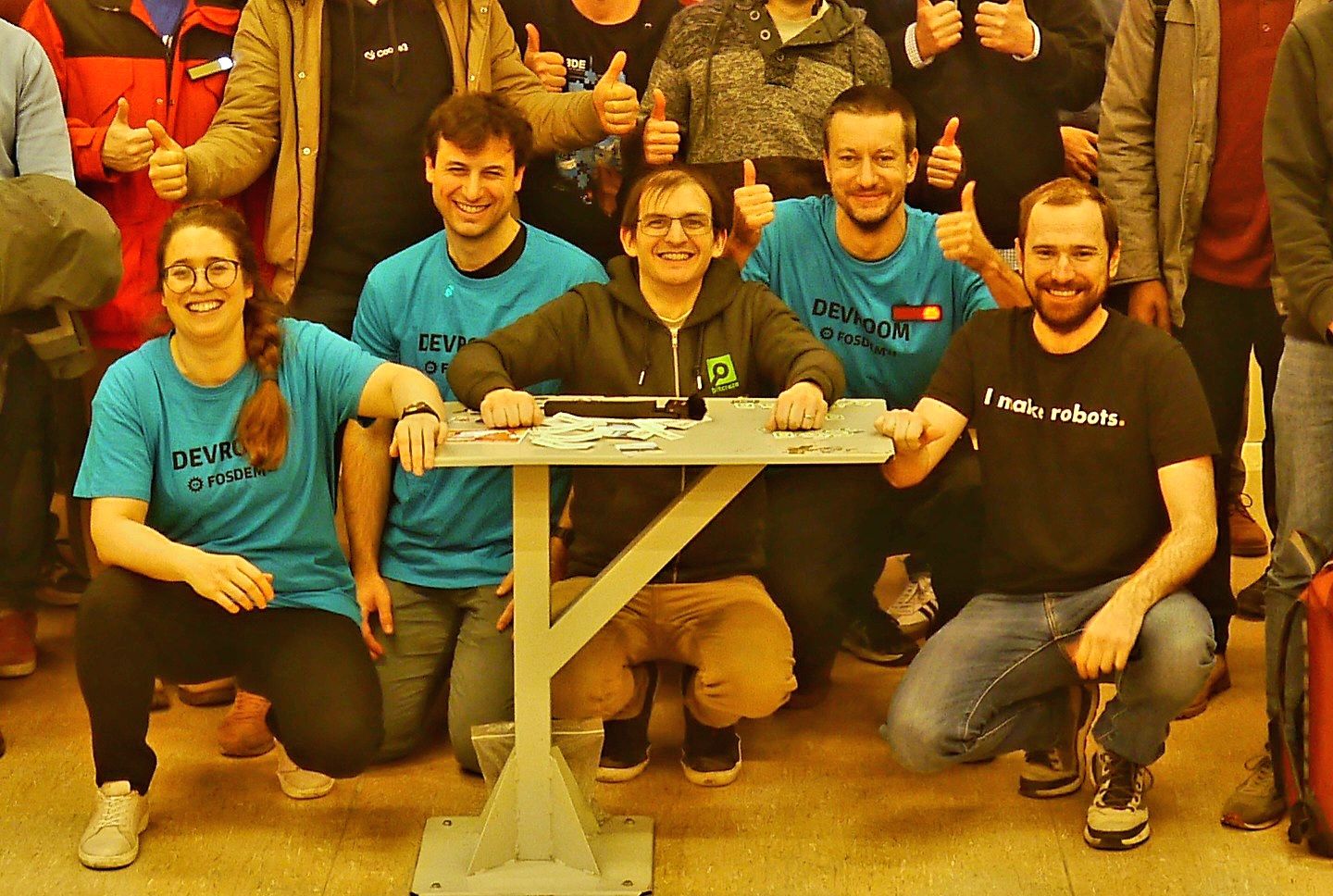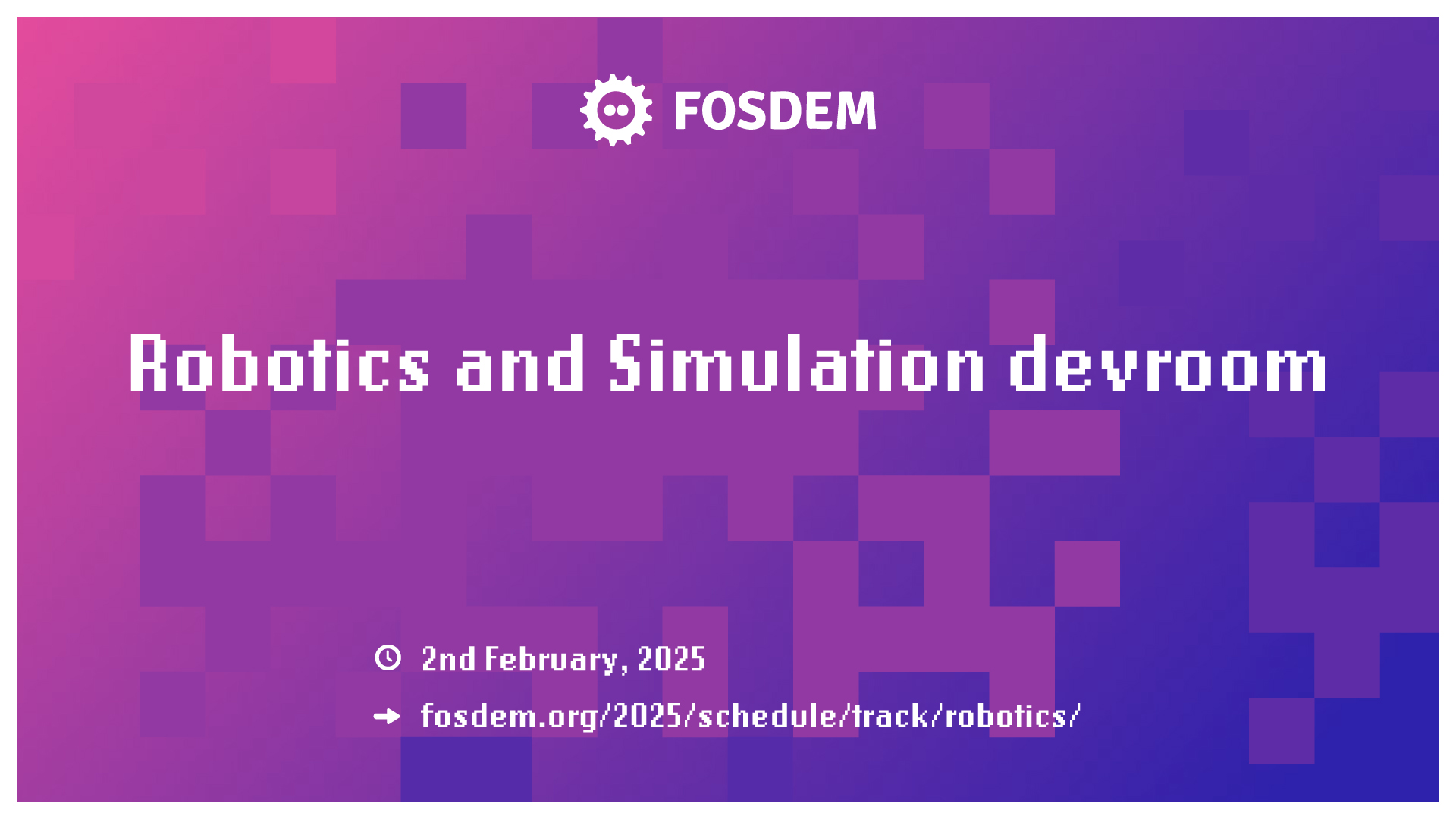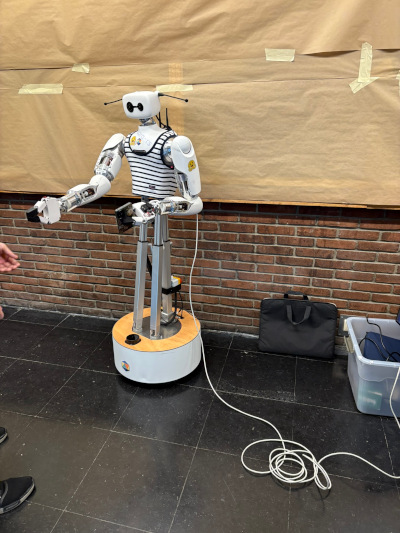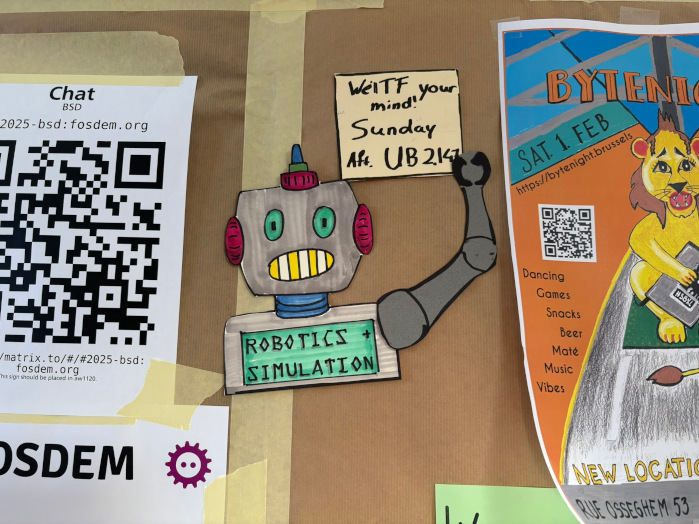
A Roboticist Visits FOSDEM 2025
Intro
This year, I paid my first visit to FOSDEM (Free and Open Source Software Developers’ European Meeting) and helped organize the Robotics and Simulation Devroom. This blog post summarizes my experience.
Last year, Kimberly McGuire approached me about organizing a robotics devroom at FOSDEM. One thing led to another, and we assembled a dream team of organizers for the “Robotics and Simulation Devroom”:
- Arnaud Taffanel (Bitcraze)
- Fred Gurr (Eclipse Foundation)
- Kimberly McGuire (Independent)
- Lucas Chiesa (Ekumen)
- Mat Sadowski (me)

and just like that, I set off for a Club Mate-fueled endeavor where hackers meet open-source—or should I say, make open-source possible.
What sets FOSDEM apart from other conferences I attended in the last couple of years is the fact that the event is free to attend. I think it does not get more open-source than this.
The Robotics and Simulation devroom

Our room hosted the first Robotics devroom in FOSDEM’s history. In the last section of this blog post, I’ll provide a list of robotics-related talks from previous FOSDEMs. We had a room for a half-day and managed to squeeze in 14 talks in less than four hours. This is largely due to many presenters agreeing to turn their talks into lightning talks. The room was full for most of the time, with people occasionally queuing outside to enter.
The talks I found interesting
Below is a short list of talks that I found interesting and attended:
- The whole Robotics and Simulation track
- SatNOGS-COMMS: An Open-Source Communication Subsystem for CubeSats - stepping outside of my comfort zone and going more embedded. Some very interesting lessons learned about using Zephyr-RTOS
- The road to open source General Purpose Humanoids with dora-rs - very nice demo with Pollen Robotics Reachy robot and, hopefully, a step towards general robots
- Exploring Open Source Dual A/B Update Solutions for Embedded Linux - good overview on strategies for reasonable firmware update workflows and overview on what’s out there
- Discovering the Magic Behind OpenTelemetry Instrumentation - trying to expand my horizons on logging. Implementing this with ROS would make a really nice side project
- What can PyArrow do for you - Array interchange, storage, compute and transport - I’ve heard of Arrow quite a bit lately and I’m excited to look more into its IPC capabilities and zero-copy approach. Did you know that with Arrow you can seamlessly switch between Numpy, Pandas, and other libraries with zero-copy using Arrow?
- Programming ROS 2 with Rust - Julia made a nice presentation in the Rust room on using ROS 2 with Rust
- Lessons from rewriting systems software in Rust - Some interesting insights on rewriting software that I believe does not only apply to Rust. One point that drove it home was depending on other’s people code

Here is a list of talks I didn’t get to see but that I’ll catch up on once the videos are available:
- Zephyr RTOS Roasting Party
- Using embedded Rust to build an unattended, battery-powered device
- Hugging Face ecosystem for Local AI/ ML
- Apache Arrow: The Great Library Unifier
- From Supercomputer to Raspberry Pi: Building Open Source Polish Language Models
- Lessons From 10 Years of Certifying Open Source Hardware
- Augurs: a time series toolkit for Rust
- Building a watt-meter esp-rs and a rocket backend
- Automating Low-Level Firmware Validation with Robot Framework
- Infra for Drones: Lessons learned from 15 years of open source robotics
- RTCP, Racecars, video and 5g
Tips&Tricks
High Quality Proposals Wanted

This year, while organizing the Robotics and Simulation devroom, we received 24 proposals and had to make tough choices to fit them into half a day. We selected only the best and asked some speakers to condense their presentations into 5-minute lightning talks.
Some advice for next year’s applicants:
- Make a super high-quality proposal. You are competing for a speaking slot with world-class roboticists, a two-sentence abstract won’t cut it, no matter the reputation of your project
- Don’t use AI to write your proposal (reviewers can often tell, and you get huge minus points for that)
- It’s always a good idea to submit a link to your repository in the proposal. It’s great if it shows some history of development and it’s not just a handful of commits
Accommodation
I booked the accommodation within walking distance of the venue, thinking it made perfect sense to be as close to it as possible. It turns out the right question to ask yourself is: Are you going to hang out with someone after the event? If you do, where will it happen? Would you prefer to commute early in the morning or at night?
On Friday and Saturday, I spent the evenings near the city center of Brussels with my fellow co-organizers and had to commute back at night towards the campus. In hindsight, I would prefer to sleep closer to the center and get to campus early.
Making it to see the talks
Often, the rooms are packed! If you find yourself going to a talk that might be popular, you get inside the room earlier. Once the rooms are full, you are not supposed to enter them for safety reasons.
Taking notes
When we organized the room, we asked the speakers to upload their slides to Pretalx. This meant that the slides showed up in the talk description and as an attendee, you could download it and make notes right there on the slides. If I just had my tablet with me!
List of robotics-adjacent talks throughout FOSDEM history
2016
2017
2018
- How to build autonomous robot for less than 2K€
- Rusty robots; Programming a self-balancing robot in Rust
2020
- ROS2: The evolution of Robot Operative System
- Making an IoT robot With NuttX, IoT.js, WebThings and more
- Introduction to Eclipse iceoryx; Writing a safe IPC framework for autonomous robots and cars
2023
2024
- Controlling a 6 degree Robot Arm using a 48K ZX Spectrum
- Dora-rs: simplifying robotics stack for next gen robots
These are all the thoughts I have on FOSDEM 2025. See you in Brussels next year!
